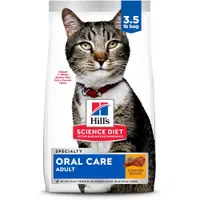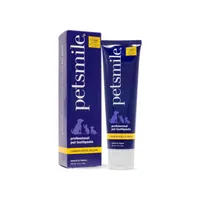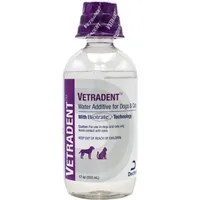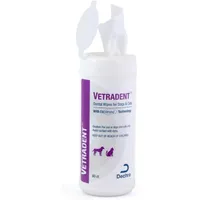How to brush your cat’s teeth: A vet’s guide
You don’t need to be a lion tamer to brush feline fangs – here’s how to brush cat teeth straight from a vet
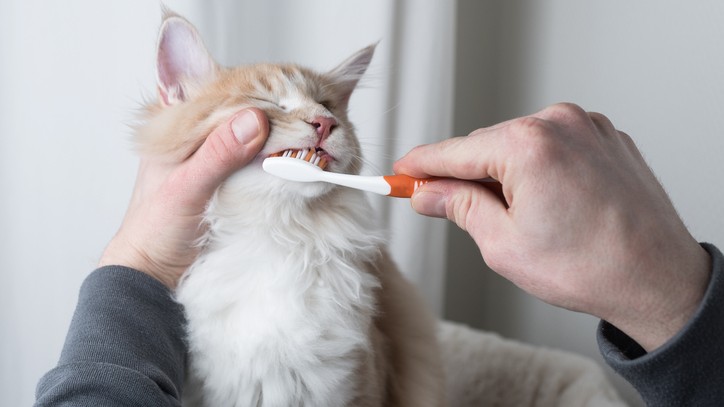
Want to brush your kitty’s chompers, but have no idea how to brush cat teeth? We’ve got you covered.
It’s important to know how to brush cat teeth because dental disease, like stomatitis, is a serious problem for felines. Not only can it cause discomfort for everyone involved (smelly cat breath, anyone?) but it can also impact your cat’s longevity and quality of life. Dental disease doesn’t just affect your cat’s mouth, either. Oral bacteria can enter the bloodstream and travel to other organs, causing or worsening problems in the heart, liver and kidneys.
It’s clear that dental health is essential and brushing your cat’s teeth is the best way to keep your cat’s mouth clean and healthy. Many pet owners think that brushing their cat’s teeth will be impossible, but the truth is, it’s quite easy and, with the right preparation and training, can even be fun.
Should you brush your cat’s teeth?
If you brush your cat’s teeth regularly, you’ll be reducing the number of nasty bacteria living in your cat's mouth, as well as removing any debris like food or hair. This will help to prevent your cat from painful gum disease, known as gingivitis
It will also keep each tooth root healthy so that your cat can hang on to their pearly whites for as long as possible! Spending time regularly brushing your cat's teeth has the added benefit of allowing you to check their mouth for any sore areas, lumps, or diseased teeth.
Spotting these signs early and informing your vet will help your cat get any treatment that they need as soon as possible. If you don’t manage to brush your cat’s teeth, they’ll be more at risk of tooth loss and painful dental infections, which in extreme cases can even lead to sepsis. However, feeding the best dry cat food or, even better, a specially formulated diet to promote dental health can also be helpful.
Follow our step-by-step guide below to train your cat to love having her teeth brushed every day.
Get the best advice, tips and top tech for your beloved Pets
Hill's Science Diet Oral Care | Amazon
This cat food is clinically proven to reduce plaque and tartar buildup thanks to an interlocking fiber technology that cleans teeth to help freshen breath with every bite.
How to teach your cat to accept a toothbrush
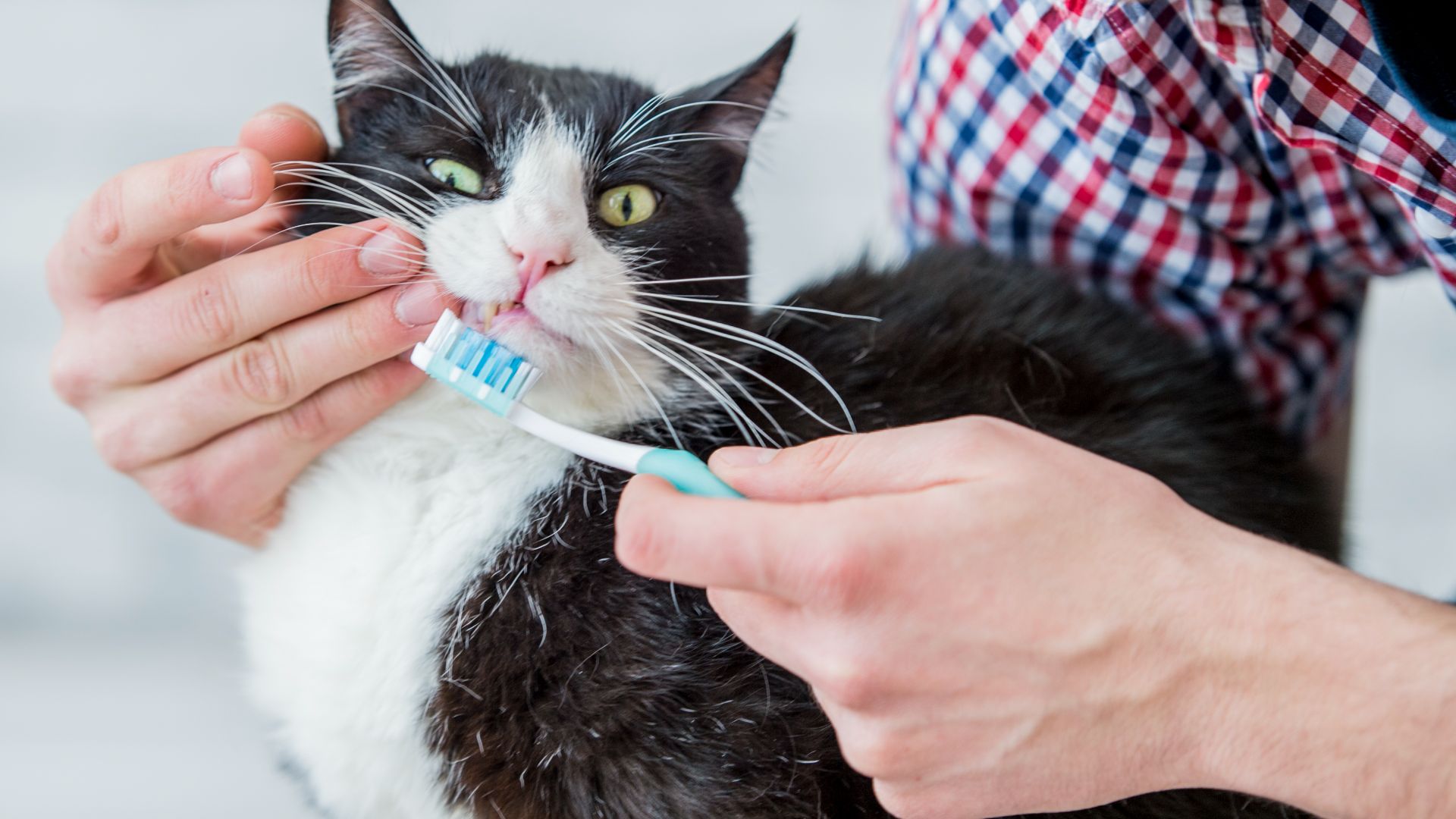
Choose the right dental products
Never use human toothpaste on your cat – these products aren’t meant to be swallowed and could be harmful to your cat. Instead, look for toothpaste specifically formulated for pets. They come in a variety of flavors, so try experimenting to see which your cat likes the best.
When it comes to choosing a toothbrush, you can use a full-sized toothbrush, a finger brush, or even a piece of gauze to clean your cat’s teeth. Whichever works best for both you and your cat is perfectly fine to use.
Petsmile Professional Pet Toothpaste
This toothpaste is the only dog toothpaste approved by the Veterinary Oral Health Council. It reduces tartar and plaque, brightens teeth, freshens breath.
Let your cat explore these fun new “toys”
Your cat probably won’t appreciate having a toothbrush shoved in her mouth right off the bat. Give her time to sniff and explore the toothbrush so she can see that there’s nothing for her to be afraid of. You can even let her taste the toothpaste to find a flavor that she likes.
Use positive reinforcement such as praise, petting or the best cat treats and best cat toys to encourage her to view the experience as something fun and rewarding.
How to brush your cat’s teeth
Start small and gradually
Once your cat has got used to the toothbrush and toothpaste, you can start to slowly introduce the concept of brushing. For most people, it’s easiest to do this with your cat sitting in your lap. You can also ask a friend or family member to hold your cat for you.
Gently lift your cat’s lip and lightly brush one or two teeth with your toothbrush. Then back off for a moment and allow your cat some time to process this new sensation. Keep your sessions short at first, even if your cat seems to enjoy them. The key is to make the process quick and fun, so your cat looks forward to more.
Build up to a full mouth brushing
As your cat learns to tolerate and even appreciate having her teeth brushed, you can gradually build up to brushing more teeth in each sitting. Focus on using moderate pressure – about the same as what you’d use to brush your own teeth.
Most of the bacteria that cause dental disease accumulate along the gum line, so pay special attention to this area. Remember to always keep your brushing sessions fun and upbeat. If your cat seems stressed by the process, take a break and try again later.
Establish a home dental care routine
The best way to prevent dental disease is to brush your cat’s teeth once a day, every day. Try to establish a routine where you brush your cat’s teeth at the same time every day, such as after a meal, so you’ll be less likely to forget.
If daily brushing is too daunting right now, aim to complete a full mouth brushing at least a couple of times per week. As your cat becomes more comfortable with the process, you can gradually build up to brushing her teeth daily.
Can I clean my cat’s teeth without brushing?
Daily brushing is the best way to prevent dental disease, but dental care products can help protect your cat’s teeth in between brushings. Products such as dental treats, diets, and water additives can help prevent plaque build-up and slow the progression of existing dental disease.
Look for products labeled with the Veterinary Oral Health Council (VOHC) seal, which certifies that the product has been tested and proven to reduce plaque build-up. It’s important to note that these products aren’t a cure for existing dental disease, but they are a great way to stop problems from arising. And your cat will love them, too.
Dechra Vetradent Water Additive for Dogs and Cats | Amazon
This easy-to-use water additive contains zinc chloride and citric acid to reduce bad breath and restore pH balance. It is odorless, tasteless and colorless.
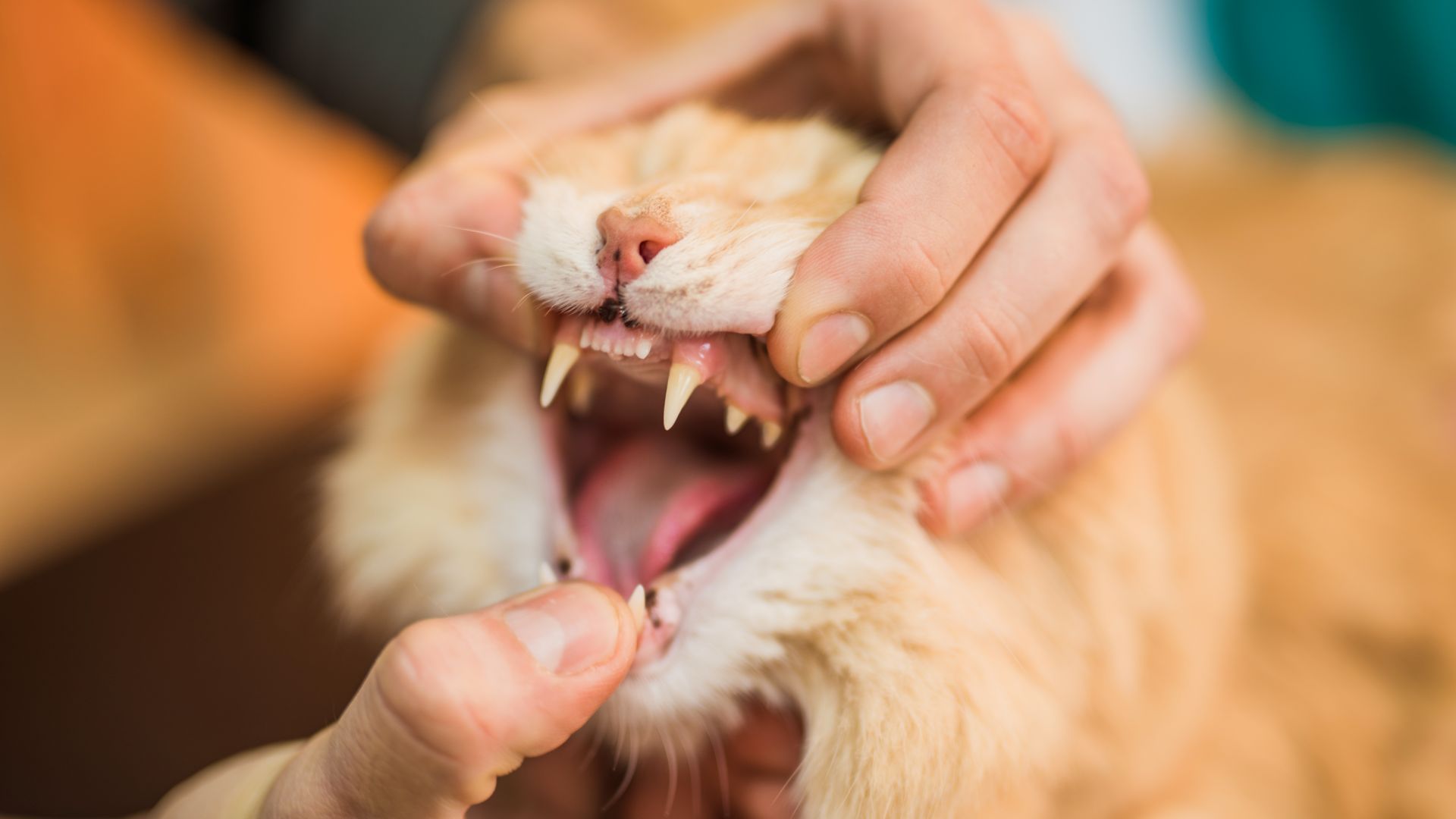
Don’t forget to follow up with your vet
Once dental disease starts, the only way to treat it is by visiting your veterinarian for an examination and a professional dental cleaning. Your cat should visit your vet at least once a year for a check-up, so your vet can catch potential dental problems early.
At home, you can monitor your cat for symptoms such as red or bleeding gums, bad breath, yellow tartar build-up along the gum line and pain when chewing. If you notice your cat has any of these symptoms, it’s time to discuss a dental cleaning with your vet. They can also recommend dental products and home care routines to ensure your cat gets the maximum benefit from her dental care.
Vetradent Dental Wipes for Dogs and Cats
These wipes are scientifically formulated to reduce tartar and have a natural, organic vanilla flavour your pet will love
When to start brushing your cat’s teeth
Just like humans, kittens have baby teeth that come through at a few weeks of age. Their temporary baby teeth fall out at around six months old, and their permanent adult teeth appear in their place. So, you might think that there's no point in getting the toothbrush out until your kitten has their permanent adult teeth since the others are going to fall out anyway!
However, although brushing your kitten's baby teeth won't benefit the teeth themselves, it will allow your kitty to get used to the experience. Allowing your kitten to get familiar with the toothbrush and toothpaste will make it more likely that they will accept toothbrushing as part of their long-term routine.
Therefore, if you’re wondering not just how to brush cat teeth, but also when to start brushing, you should begin as soon as possible. If you have an older cat and haven't yet started brushing their teeth, don't despair, you can still improve your cat's oral health by toothbrushing at any age!
Here’s some more information about the kitten teething process.
How often should I brush my cat’s teeth?
Cats need their teeth brushed every day, just like we do. Regular brushing helps remove residual food particles, scrub away bacteria, break up plaque, and stimulate healthy blood flow to the gums.
While it may take some patience at first, you can easily teach your cat to tolerate and even enjoy having her teeth brushed every day. Remember to start out slow and keep the experience fun for your cat. Before long, she’ll look forward to her daily dental care.
Read next: I had no idea my cat had gingivitis! Here's how to prevent it

Bethany is an experienced writer who has been writing across the pets and equestrian sector for eight years.
Dr. Elizabeth Racine is a small animal general practice vet covering all things pet health and wellness. Her special interests include veterinary behavior, nutrition, and internal medicine.
As a freelance writer, Dr. Racine has written content for major companies in the industry such as the American Kennel Club, Merck Animal Health, Bayer PetBasics, Elanco, and CareCredit. In her free time, Dr. Racine enjoys playing trampoline dodgeball, hiking with her beagle Dasher, and spending time with her three mischievous cats.
- Bethany StoneFreelance Writer
